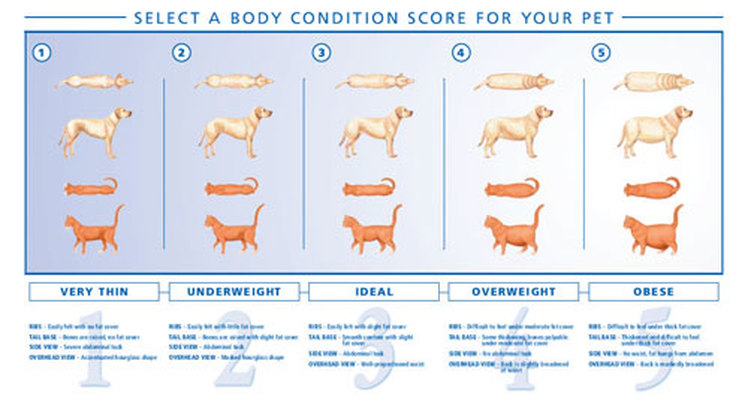Weight control help for a longer, happier life.
Obesity is a growing concern among companion animals. It is estimated that a 1/3 to 1/2 of dogs and cats are overweight. Being overweight increases the risk of diabetes mellitus, osteoarthritis, heart disease, respiratory disease and others. Studies found that lean dogs lived on average 2 years longer than their overweight counterparts!
Prevention and management of obesity starts with monitoring your pet's body fat using their body condition score (BCS), not their actual weight. We use the 5 point scale where 1 indicates the patient is too thin, 5 indicates the patient is obese and 3 is an ideal body condition. Check out the chart at the bottom of this page and fit your pet into a BCS. If you'd like help, stop in and use our scale for no charge. You'll find the chart in Reception as well and any of our staff can guide you through it.
If your pet has been recently spayed or neutered, they will require on average 25% fewer calories to maintain their current weight. If their weight is not ideal even now, use these tools to help achieve slow, but steady, weight loss until the ideal weight (BCS 3/5) is reached.
Tools for successful weight loss:
1) Exercise
- Provides not only positive attention during a walk/run but also assists with fat burning.
- For cats or small dogs, indoor games of hiding meals in small aliquots, the use of 'Slim Ball' or similar interactive toy or general chase games (e.g. feather on a stick or laser pointer) can help burn calories.
- Decreasing portion size (aim for 10-25% reduction of food monthly) works unless we are reaching very low volumes, when a lower calorie diet may be required. Remember that the 'guidelines' on the bag are often high. Tailor the amount to what maintains a healthy weight in YOUR pet.
- Changing diet to a lower calorie food can assist with satiety if decreasing portion size results in an animal feeling hungry and begging OR if we are concerned that a decrease in portion size may result in nutrient deficiencies on their current diet. This is a problem with calorie-dense diets.
- We know giving treats or table scraps is a way to interact with your pet and show your love. We suggest a few tricks to limit those treat calories
- Set aside the dinner meal in the morning and feed the kibbles out of the dinner as the 'treats'. That way, you can give as many as you want and all the leftovers are dinner, so there is no increase in calories.
- Use vegetables instead of cookies. Avoid high-starch (like carrots) except for rarely, but use cucumber, peppers, broccoli...
- Break treats into multiple small pieces. This is good if you have someone who simply must give a treat (like grandma!). If you can teach them to give a smaller piece, you will reduce the calories too.
- Ensure all family members or anyone in charge of feeding are on board for the weight loss plan to be successful
- We recommend no more than 2% of body weight loss per week PARTICULARLY FOR CATS. We do NOT want sudden changes in diet or weight for any animal, but cats are particularly at risk if we do too much too soon. Getting an obese pet to normal weight can take years and it can take a lot to get it rolling. Don't get discouraged!
- Monthly weigh-ins allow you to monitor your pet’s weight loss and tailor the plan as weight loss progresses. It also gives you a way to check in for new ideas if you are struggling. Remember that coming in to weigh your pet never costs you anything at Sooke Vet and we love helping you take care of your friend!
For more specific help, visit us at the clinic and ask for help in tailoring a more specific weight loss program.
